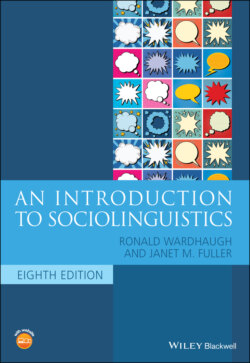Читать книгу An Introduction to Sociolinguistics - Ronald Wardhaugh, Janet M. Fuller - Страница 25
Directions of influence
ОглавлениеThere are several possible relationships between language and culture. One is that social structure may either influence or determine linguistic structure and/or behavior. Certain evidence may be adduced to support this view. For instance, given the evidence of the age‐grading phenomenon (i.e., young children speak differently from older children, and, in turn, children speak differently from mature adults), we could argue that the social organization of age groups influences the language used in these groups. Another possible piece of evidence for this direction of influence is studies which show that the varieties of language that people use reflect such matters as their regional, social, or ethnic origin and possibly even their gender. In both cases it might be that social structures account for – possibly even determine – linguistic differences.
A second possibility is directly opposed to the first: linguistic structure and/or behavior may either influence or determine social structure or worldview. This is the view that is behind the Whorfian hypothesis, which we will discuss in more detail in the next section. Such a view is behind certain proposed language reforms: if we change the language we can change social behavior, for example, a deliberate reduction in sexist language not only reflects a desire to combat sexism, but is also aimed at raising consciousness about the prevalence of sexist attitudes.
A third possible relationship is that the influence is bi‐directional: language and society may influence each other. Certain language reforms can also be seen as relying on this perspective; the reforms are made because of changes in societal norms, for example, awareness that generic ‘he’ is not inclusive may increase the power of women and girls, enabling them to claim inclusion. Consequently, language change and a greater awareness of gender equality co‐occur, hand in glove as it were.
A fourth possibility is to assume that there is no relationship at all between linguistic structure and social structure and that each is independent of the other. A variant of this possibility would be to say that, although there might be some such relationship, present attempts to characterize it are essentially premature or unproveable, given what we know about both language and society.
